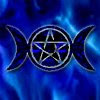First, go pick up Scott Cunningham's book, "Incenses, Oils, and Brews." Here's a link:
http://www.borders.com/online/store/TitleDetail?sku=0875421288
This is the latest version. I have one of the earliest, with the Robin Wood cover, so mine will be different. However, my poor book has suffered in the long years of use, and has literally fallen apart at the binding. (sigh) Because we've used it so many times for Smelly Arts Workshops, as soon as you open it, the scent of incenses wafts up. I'm going to hate to replace it.
Anyway... IMHO, there's no reason why anyone can't have lovely incenses, oils and brews in their homes. Anyone who cooks likely has many of the most common ingredients like cloves, cinnamon, and allspice already in their homes. I've been known to throw a stick of cinnamon, a handful of whole allspice, and a pinch of whole cloves in a small pot of hot water on the stove minutes before guests arrive just for the welcoming scent.
I lucked into a small pot of Corning Visionware in the thrift store, and this is my favorite brewing pot. Visionware is glass, and therefore non-reactive. It won't affect your brews in any way, nor do you have to keep it for "witchy" things only. I do, but that's a choice, not an imperative. I highly suggest a trip to the thrift store to search for these ellusive brown glass pots. They're becoming difficult to find.
While at the thrift store once, I also lucked into one of the tiny potpourri crock pots, so I have one of those as well. They may be slower to heat up, but you don't have to watch them as much when you've got a little brew simmering. I rarely make up any large amounts of a brew requiring a regular-sized crock pot, but if I ever do, I'll get one. So far in the past twenty years, it's never been needed by my coven or myself.
Like many witches, I collect mortar and pestles for their esthetic beauty as well as their usefulness. However, I also keep an electric coffee grinder as well. I have one for grinding coffee, and another for grinding herbs. The top of the herb grinder is well marked with red nail polish so I don't confuse them.
You'll want to have a box of the snack-sized zip top bags handy, as well as a Sharpie and stick-on address labels as well. Write on the label what the scent is before sticking it on the bag. That way, if you make a mistake, you've only wasted a label. Don't forget to date it.
Of course, you'll want a place to test your creations, right? Right. So, this means a censer. Don't panic if you don't have one of the fancy kinds made of brass or ceramic. All you need is a heatproof container and sand or kitty litter. Put the sand in the container, and make sure there's enough sand to disperse the heat, just in case. Better too much than not enough! I've been known to use a terra cotta plant pot and fill it with kitty litter. Don't get anal, okay?
Finally, you need the special charcoal briquettes made for burning incense. No, not the same thing as you dump on the charcoal grill every weekend! The briquettes I refer to resemble tiny hockey pucks, with a indentation in the center for dumping herb powders on. Each briquette can last an hour or so, and are perfect for the average home ritual.
Now, the reason we call this a Smelly Arts Workshop should be painfully obvious. The reason we wait until fall is so we can do this outside. We'll test a whole bunch of scents, so using the air outdoors makes perfect sense. Make just one of the stronger smelling ones inside and add just a little too much...you'll get the idea quickly. This is how you learn what a "pinch" really means!
Now grab up your BOS (Book of Shadows). You'll want to record what the formula you used was for each incense you keep. For instance, I'm highly allergic to eucalyptus, a common ingredient in some incenses. We substitute camphor. You'll find substitutions listed in the book. It really helps to note your personal formulas. After all, you may not remember next year what you did.
Now go find the recipes you want to do. You may have to make a trip to the local herb and oil shop to find some ingredients. Buy the pure essential oils, please. They do make a difference, even if they cost more.
Ready? Go make your own scents! More tomorrow!
Subscribe to:
Post Comments (Atom)

2 comments:
The Scott Cunningham book is one of my favorites for incense making. There are a couple others out there, but this is the one I recommend for my students as well.
You can't go wrong with it. I have one of the really old copies around here that I found at a half price books years ago as well as the newer one.
I also have enjoyed Incense: Crafting and Use of Magickal Scents by Carl Neal and Wylundt's Book of Incense by Wylundt. There are some other nifty recipes in Kitchen Witchery: A Compendium of Oils, Unguents, Incense, Tinctures, and Comestibles by Marilyn F. Daniel.
Great tutorial by the way! I am adding you to my favorite blogs. :)
The Marilyn F. Daniel book was already on my TBB list, but I'll happily look up the others.
Thank you very much, Rachel!
Post a Comment